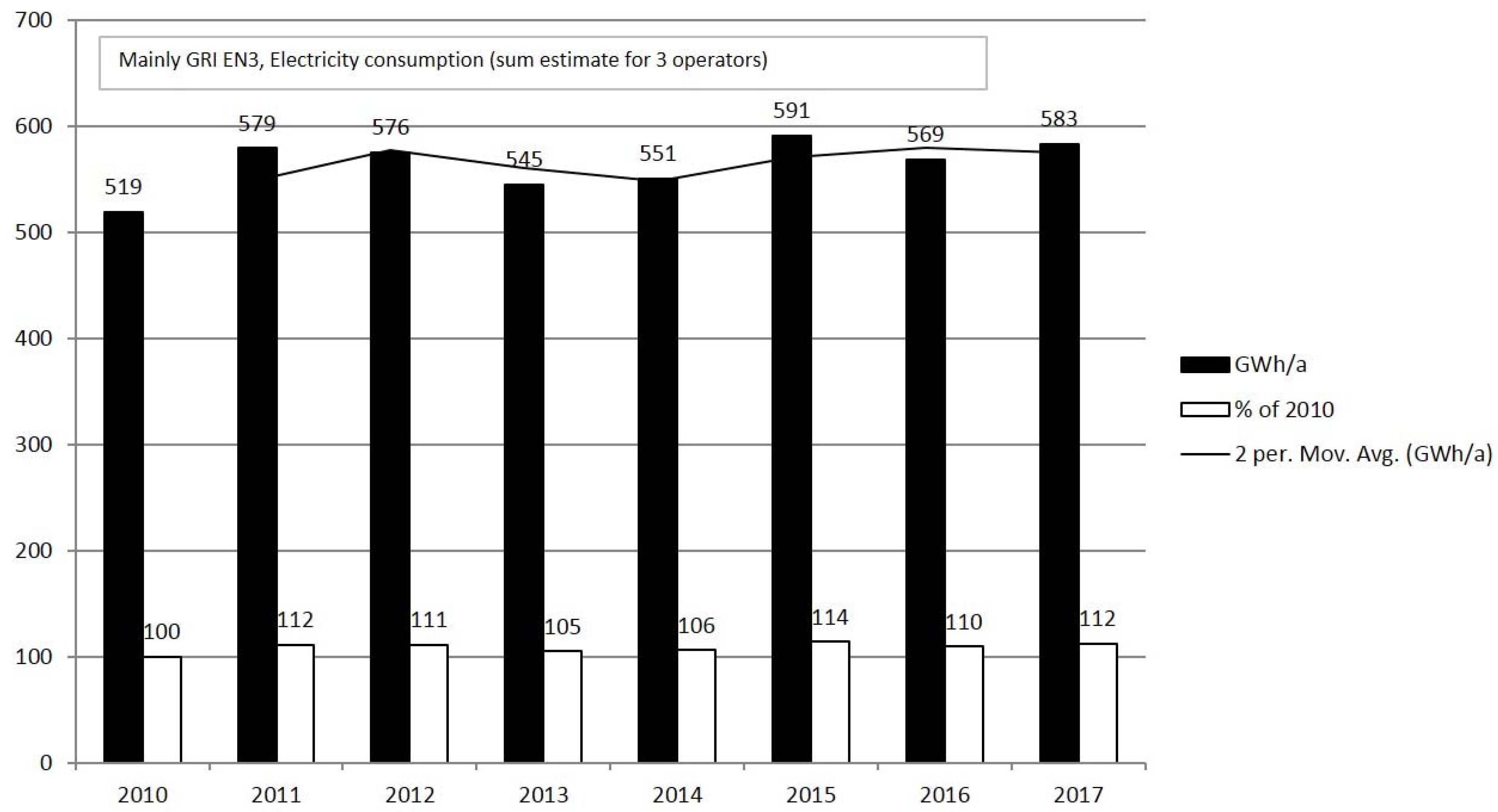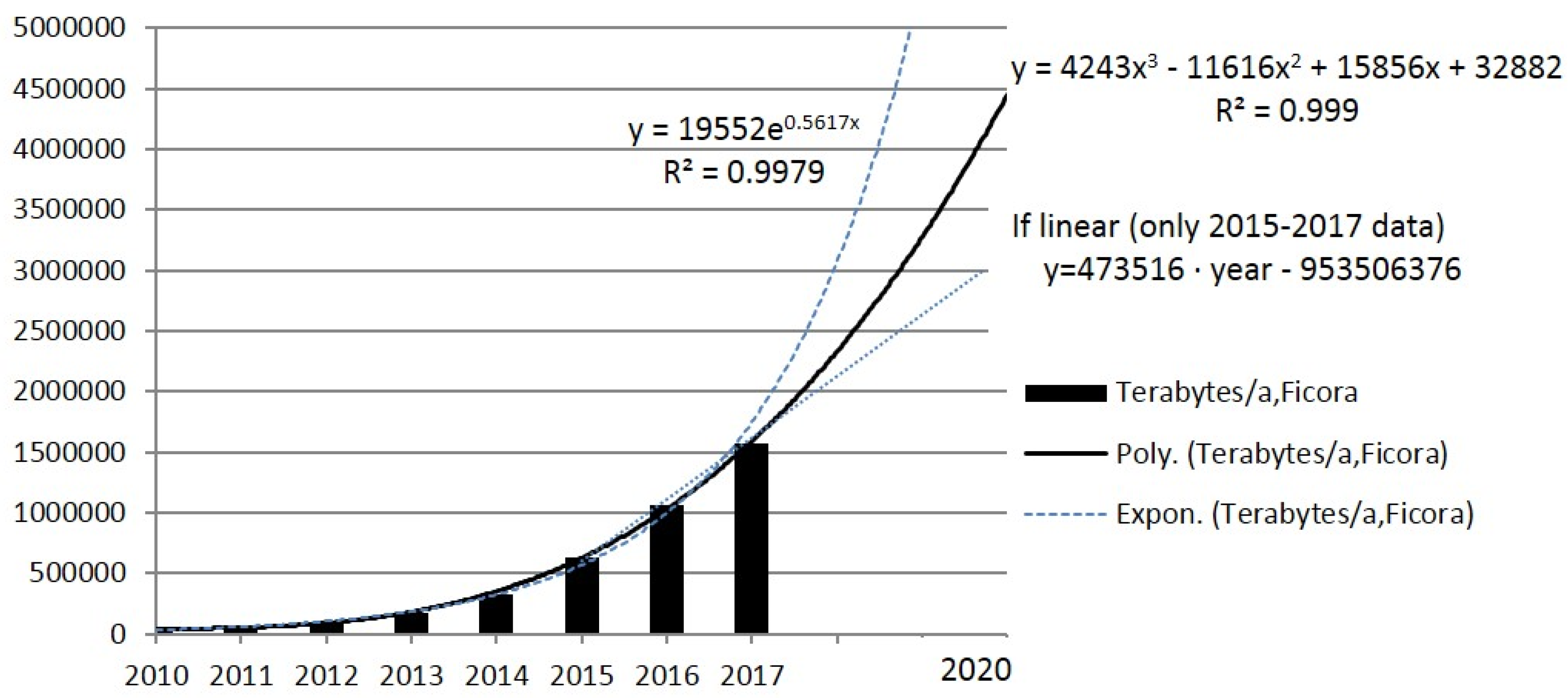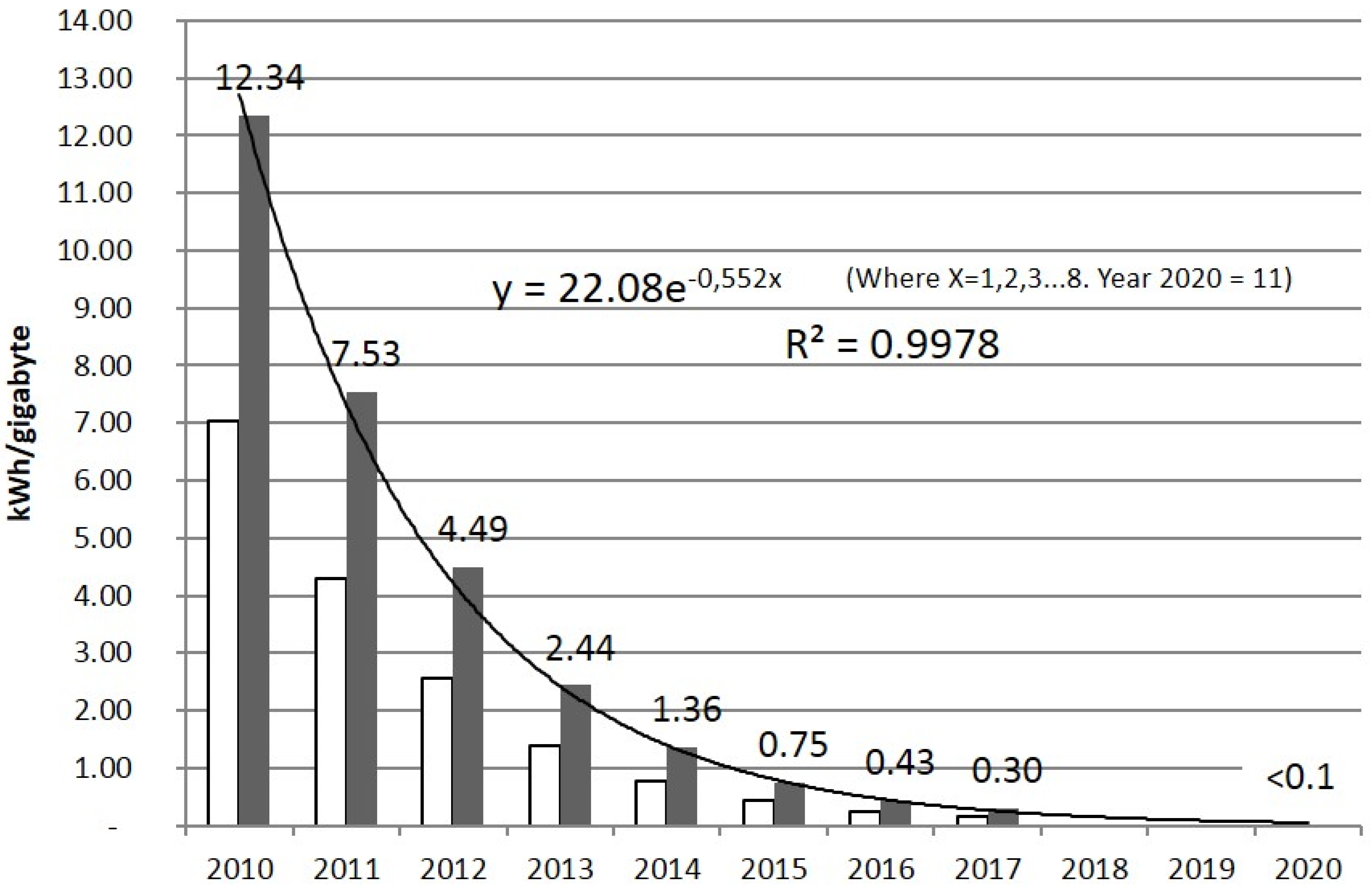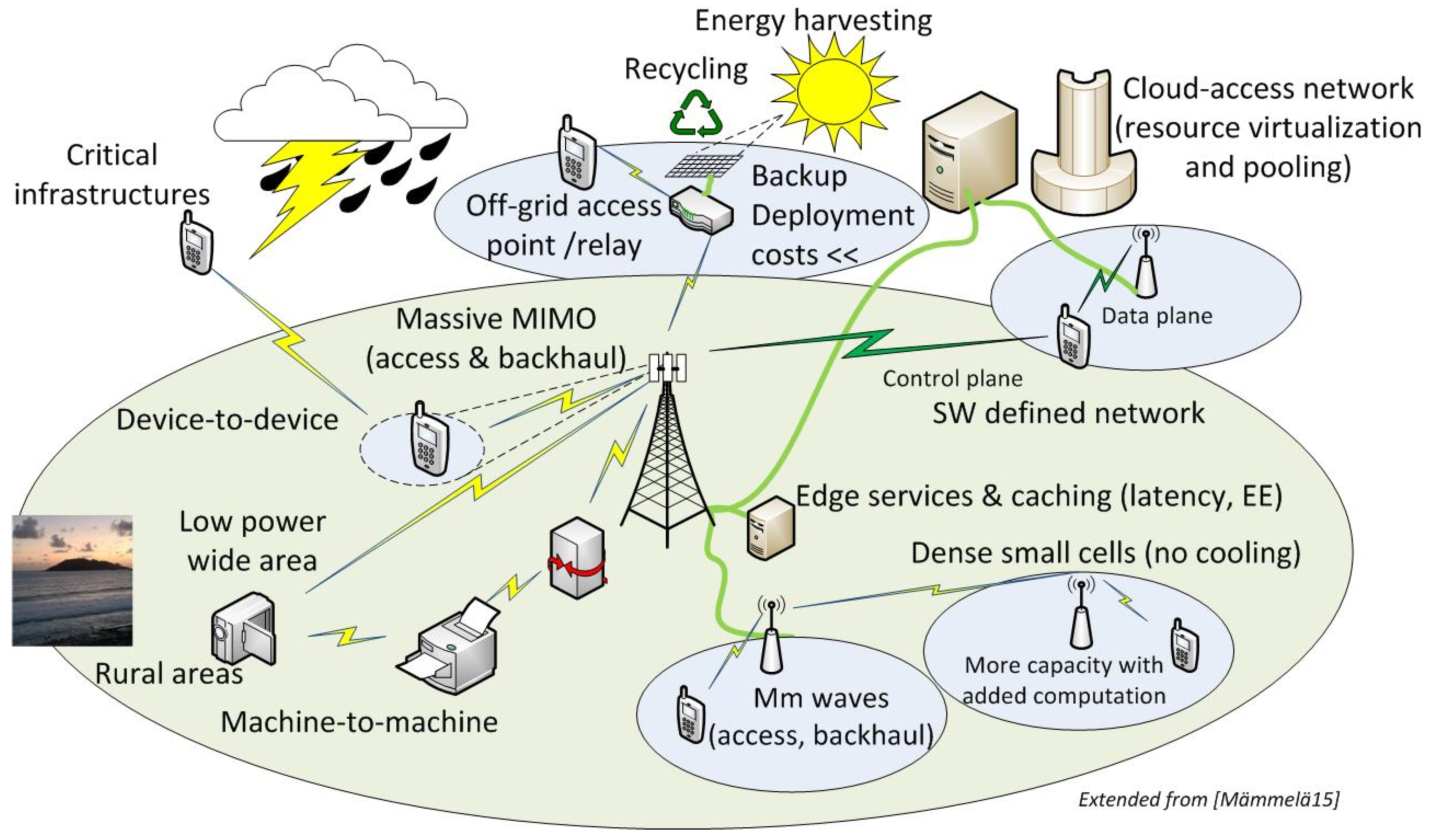Evaluating the Energy Consumption of Mobile Data Transfer—From Technology Development to Consumer Behaviour and Life Cycle Thinking
Abstract
:1. Introduction
2. Materials and Methods
3. Results
3.1. Estimation of Mobile Operators’ Energy Consumption and Energy Intensity of Data Transfer in Finland
3.2. Energy Efficiency Related Developments in Mobile Networks
4. Discussion
- -
- The impact of mobile networks within the life cycle of electronic services,
- -
- the impact of user behaviour on the life cycle environmental impacts of electronic services and
- -
- the importance of widening the perspective from energy use to resource use and other environmental impacts.
4.1. Role of Mobile Access Networks in the Life Cycle of Electronic Services
4.2. Impact of User Behaviour on ICT Related Energy Consumption and Environmental Impacts
4.3. From Energy Consumption to Resource Use and Other Environmental Impacts
5. Conclusions
Author Contributions
Funding
Acknowledgments
Conflicts of Interest
References
- CISCO. Cisco Visual Networking Index Global Mobile Data Traffic Forecast Update, 2016–2021 White Paper; CISCO: San Jose, CA, USA, 2017; Available online: https://www.cisco.com/c/en/us/solutions/collateral/service-provider/visual-networking-index-vni/vni-forecast-qa.pdf (accessed on 17 July 2018).
- Katsigiannis, M.; Hämmäinen, H. Energy consumption of radio access networks in Finland. Telecommun. Syst. 2014, 55, 241–251. [Google Scholar] [CrossRef]
- Andrae, A.; Edler, T. On Global Electricity Usage of Communication Technology: Trends to 2030. Challenges 2015, 6, 117–157. [Google Scholar] [CrossRef]
- ITU Facts and Figures 2017. Available online: https://www.itu.int/en/ITU-D/Statistics/Documents/facts/ICTFactsFigures2017.pdf (accessed on 27 November 2017).
- ITU Facts and Figures 2016. Available online: https://www.itu.int/en/ITU-D/Statistics/Documents/facts/ICTFactsFigures2016.pdf (accessed on 27 November 2017).
- FICORA Statistics Service 2018, Mobile Data Transmission Volume. Available online: https://www.viestintavirasto.fi/en/statisticsandreports/statistics/2013/mobiledatatransmissionvolume.html (accessed on 28 May 2018).
- OECD. OECD Digital Economy Outlook 2017; OECD: Paris, France, 2017; ISBN 9789264276260. [Google Scholar]
- FICORA Telecommunication Markets in the Nordic and Baltic Countries. 2017. Available online: https://www.viestintavirasto.fi/en/statisticsandreports/studiesandsurveys/telecommunicationmarketsinthenordiccountries-julkaisu.html (accessed on 9 July 2018).
- Malmodin, J.; Lundén, D. The energy and carbon footprint of the ICT and E&M sector in Sweden 1990–2015 and beyond. In Proceedings of the International Conference on ICT for Sustainability (ICT4S), Amsterdam, Netherlands, 30–31 August 2016; pp. 209–218. [Google Scholar]
- Malmodin, J.; Lundén, D.; Moberg, Å.; Andersson, G.; Nilsson, M. Life Cycle Assessment of ICT: Carbon Footprint and Operational Electricity Use from the Operator, National and Subscriber Perspective in Sweden. J. Ind. Ecol. 2014, 18, 829–845. [Google Scholar] [CrossRef]
- Scharnhorst, W.; Hilty, L.M.; Jolliet, O. Life cycle assessment of second generation (2G) and third generation (3G) mobile phone networks. Environ. Int. 2006, 32, 656–675. [Google Scholar] [CrossRef] [PubMed]
- Schien, D.; Shabajee, P.; Yearworth, M.; Preist, C. Modeling and assessing variability in energy consumption during the use stage of online multimedia services. J. Ind. Ecol. 2013, 17, 800–813. [Google Scholar] [CrossRef]
- Schien, D.; Preist, C. Approaches to energy intensity of the internet. IEEE Commun. Mag. 2014, 52, 130–137. [Google Scholar] [CrossRef] [Green Version]
- FICORA Ficora Statistics 2018. Market Shares of Mobile Subscriptions. Available online: https://www.viestintavirasto.fi/en/statisticsandreports/statistics/2013/marketsharesofmobilesubscriptions.html (accessed on 28 May 2018).
- Elisa Annual Report and Corporate Responsibility Report 2014. Available online: http://corporate.elisa.com/attachment/content/Elisa_Annual_Report_2014.pdf (accessed on 17 July 2018).
- Han, C.; Harrold, T.; Armour, S.; Krikidis, I.; Videv, S.; Grant, P.M.; Haas, H.; Thompson, J.S.; Ku, I.; Wang, C.X.; et al. Green radio: Radio techniques to enable energy-efficient wireless networks. IEEE Commun. Mag. 2011, 49, 46–54. [Google Scholar] [CrossRef]
- Jesson, J.K.; Matheson, L.; Lacey, F.M. Doing Your Literature Review; Sage Publications Ltd.: Thousand Oaks, CA, USA, 2011; ISBN 978-1-84860-153-6. [Google Scholar]
- Aslan, J.; Mayers, K.; Koomey, J.G.; France, C. Electricity Intensity of Internet Data Transmission: Untangling the Estimates. J. Ind. Ecol. 2017, 1–14. [Google Scholar] [CrossRef]
- Coroama, V.C.; Hilty, L.M.; Heiri, E.; Horn, F.M. The direct energy demand of internet data flows. J. Ind. Ecol. 2013, 17, 680–688. [Google Scholar] [CrossRef]
- Report ITU-R M.2083. IMT Vision—Framework and Overall Objectives of the Future Development of IMT for 2020 and Beyond; ITU: Geneva, Switzerland, 2015; p. 21. [Google Scholar]
- The European Commission’s science and knowledge service. JRC EU Code of Conduct on Energy Consumption of Broadband Equipment; JRC Technical Report Version 6; Publications Office of the European Union: Brussels, Belgium, 2016. [Google Scholar]
- Ericsson. Mobility Report; Ericsson: Stockholm, Sweden, 2016. [Google Scholar]
- Mämmelä, A. Energy Efficiency in 5G Mobile Networks. In Proceedings of the Networking 2015 Conference, Toulouse, France, 20–22 May 2015; Available online: https://www.irit.fr/networking2015/files/keynote-Mammela.pdf (accessed on 17 July 2018).
- Marzetta, T.L. Noncooperative cellular wireless with unlimited numbers of base station antennas. IEEE Trans. Wirel. Commun. 2010, 9, 3590–3600. [Google Scholar] [CrossRef]
- Boccardi, F.; Heath, R.; Lozano, A.; Marzetta, T.L.; Popovski, P. Five disruptive technology directions for 5G. IEEE Commun. Mag. 2014, 52, 74–80. [Google Scholar] [CrossRef] [Green Version]
- Desset, C.; Debaillie, B.; Louagie, F. Modeling the hardware power consumption of large scale antenna systems. In Proceedings of the 2014 IEEE Online Conference on Green Communications, 12–14 November 2014; IEEE: Piscataway, NJ, USA, 2014; pp. 1–6. [Google Scholar]
- Björnson, E.; Sanguinetti, L.; Hoydis, J.; Debbah, M. Optimal Design of Energy-Efficient Multi-User MIMO Systems: Is Massive MIMO the Answer? IEEE Trans. Wirel. Commun. 2015, 14, 3059–3075. [Google Scholar] [CrossRef] [Green Version]
- Hossain, M.M.A.; Jantti, R.; Cavdar, C. Dimensioning of PA for massive MIMO system with load adaptive number of antennas. In Proceedings of the 2014 IEEE Globecom Workshops (GC Wkshps), Austin, TX, USA, 8–12 December 2014; IEEE: Piscataway, NJ, USA, 2014; pp. 1102–1108. [Google Scholar] [Green Version]
- Apilo, O.; Lasanen, M.; Mammela, A. Unequal Power Amplifier Dimensioning for Adaptive Massive MIMO Base Stations. In Proceedings of the 2016 IEEE 83rd Vehicular Technology Conference (VTC Spring), Nanjing, China, 15–18 May 2016; IEEE: Piscataway, NJ, USA, 2016; pp. 1–6. [Google Scholar]
- Liu, W.; Han, S.; Yang, C. Energy efficiency comparison of massive MIMO and small cell network. In Proceedings of the 2014 IEEE Global Conference on Signal and Information Processing (GlobalSIP), Atlanta, GA, USA, 3–5 December 2014; pp. 617–621. [Google Scholar] [CrossRef]
- Xu, X.; He, G.; Zhang, S.; Chen, Y.; Xu, S. On functionality separation for green mobile networks: Concept study over LTE. IEEE Commun. Mag. 2013, 51, 82–90. [Google Scholar] [CrossRef]
- Lu, L.; Li, G.Y.; Swindlehurst, A.L.; Ashikhmin, A.; Zhang, R. An Overview of Massive MIMO: Benefits and Challenges. IEEE J. Sel. Top. Signal Process. 2014, 8, 742–758. [Google Scholar] [CrossRef]
- Swindlehurst, A.L.; Ayanoglu, E.; Heydari, P.; Capolino, F. Millimeter-wave massive MIMO: The next wireless revolution? IEEE Commun. Mag. 2014, 52, 56–62. [Google Scholar] [CrossRef]
- Wu, G.; Yang, C.; Li, S.; Li, G.Y. Recent advances in energy-efficient networks and their application in 5G systems. IEEE Wirel. Commun. 2015, 22, 145–151. [Google Scholar] [CrossRef]
- Buzzi, S.; Chih-Lin, I.; Klein, T.E.; Poor, H.V.; Yang, C.; Zappone, A. A survey of energy-efficient techniques for 5G networks and challenges ahead. IEEE J. Sel. Areas Commun. 2016, 34, 697–709. [Google Scholar] [CrossRef]
- Ge, X.; Yang, J.; Gharavi, H.; Sun, Y. Energy Efficiency Challenges of 5G Small Cell Networks. IEEE Commun. Mag. 2017, 55, 184–191. [Google Scholar] [CrossRef] [PubMed] [Green Version]
- Mämmelä, A.; Anttonen, A. Why Will Computing Power Need Particular Attention in Future Wireless Devices? IEEE Circuits Syst. Mag. 2017, 17, 12–26. [Google Scholar] [CrossRef]
- Berkhout, F.; Hertin, J. De-materialising and re-materialising: Digital technologies and the environment. Futures 2004, 36, 903–920. [Google Scholar] [CrossRef]
- Hilty, L.M.; Aebischer, B. ICT for sustainability: An Emerging Research Field. In ICT Innovations for Sustainability; Hilty, L.M., Aebischer, B., Eds.; Springer International Publishing: Basel, Switzerland, 2015; Volume 310, pp. 3–36. ISBN 9783319092287. [Google Scholar]
- Horner, N.C.; Shehabi, A.; Azevedo, I.L. Known unknowns: Indirect energy effects of information and communication technology. Environ. Res. Lett. 2016, 11, 103001. [Google Scholar] [CrossRef]
- Achachlouei, M.A. Exploring the Effects of ICT on Environmental Sustainability: From Life Cycle Assessment to Complex Systems Modelling; KTH Royal Institute of Technology: Stockholm, Sweden, 2015. [Google Scholar]
- Coroama, V.C.; Schien, D.; Preist, C.; Hilty, L.M. The Energy Intensity of the Internet: Home and Access Networks. In ICT Innovations for Sustainability. Advances in Intelligent Systems and Computing; Hilty, L.M., Aebischer, B., Eds.; Springer International Publishing: Basel, Switzerland, 2015; Volume 310, pp. 137–155. ISBN 9783319092287. [Google Scholar]
- Hischier, R.; Coroama, V.C.; Schien, D.; Achachlouei, M.A. Grey energy and environmental impacts of ICT hardware. In ICT Innovations for Sustainability. Advances in Intelligent Systems and Computing; Hilty, L.M., Aebischer, B., Eds.; Springer International Publishing: Basel, Switzerland, 2015; Volume 310, pp. 171–189. [Google Scholar]
- European Commission. Ecodesign Working Plan 2016–2019 COM(2016) 773 Final; European Commission: Brussels, Belgium, 2016. [Google Scholar]
- Hischier, R.; Wäger, P.A. The transition from desktop computers to tablets: A model for increasing resource efficiency? In ICT Innovations for Sustainability. Advances in Intelligent Systems and Computing; Hilty, L.M., Aebischer, B., Eds.; Springer International Publishing: Basel, Switzerland, 2015; Volume 310, pp. 243–256. [Google Scholar]
- Federley, M.; Nors, M.; Pihkola, H.; Behm, K. End-user perspectives on environmental sustainability and communication—Case study on media use. In Proceedings of the 2nd International Conference on ICT for Sustainability, Stockholm, Sweden, 24–27 August 2014; KTH Royal Institute of Technology: Stockholm, Sweden; VU University Amsterdam: Amsterdam, The Netherlands, 2014. [Google Scholar]
- Pihkola, H.; Nors, M.; Federley, M.; Behm, K. Environmental Awareness and Changes in the Use of Media Evaluating and Communicating the Environmental Impacts of Consumers’ Media Use; VTT Technical Research Centre of Finland: Espoo, Finland, 2014. (In Finnish) [Google Scholar]
- Seppälä, J.; Mäenpää, I.; Koskela, S.; Mattila, T.; Nissinen, A.; Katajajuuri, J.M.; Härmä, T.; Korhonen, M.R.; Saarinen, M.; Virtanen, Y. An assessment of greenhouse gas emissions and material flows caused by the Finnish economy using the ENVIMAT model. J. Clean. Prod. 2011, 19, 1833–1841. [Google Scholar] [CrossRef]
- Heikkinen, M.; Mäenpää, I.; Nissinen, A.; Salo, M. Kulutuksen Hiilijalanjäljen Seurantaa Tarvitaan. Available online: http://www.stat.fi/tietotrendit/artikkelit/2016/kulutuksen-hiilijalanjaljen-seurantaa-tarvitaan/ (accessed on 5 July 2018).
- Bates, O.; Lord, C.; Knowles, B.; Friday, A.; Clear, A.; Hazas, M. Exploring (un)sustainable growth of digital technologies in the home. In Proceedings of the Third International Conference on ICT for Sustainability (ICT4S), Rome, Italy, 5–6 June 2015; Atlantis Press: Paris, France, 2015. [Google Scholar] [Green Version]
- Müller, E.; Widmer, R.; Coroama, V.C.; Orthlieb, A. Material and energy flows and environmental impacts of the internet in Switzerland. J. Ind. Ecol. 2013, 17, 814–826. [Google Scholar] [CrossRef]
- Arushanyan, Y.; Ekener-Petersen, E.; Finnveden, G. Lessons learned—Review of LCAs for ICT products and services. Comput. Ind. 2014, 65, 211–234. [Google Scholar] [CrossRef]
- Hohenthal, C.; Moberg, Å.; Arushanyan, Y.; Ovaskainen, M.; Nors, M.; Koskimäki, A. Environmental Performance of Alma Media’s Online and Print Products; VIT: Helsinki, Finland, 2013. [Google Scholar]
- Wäger, P.A.; Hischier, R.; Widmer, R. The Material Basis of ICT. In ICT Innovations for Sustainability, Advances in Intelligent Systems and Computing 310; Hilty, L.M., Aebischer, B., Eds.; Springer International Publishing: Basel, Switzerland, 2015. [Google Scholar]
- IVL Swedish Environmental Research Agency. Unleashing the Power of Secondary Materials: A Strategic Research and Innovation Agenda for Effective Material Recycling from ELV, WEEE and Plastic Packaging Waste Streams; D5.3 of the NewInnonet Project; IVL Swedish Environmental Research Agency: Stockholm, Sweden, 2017. [Google Scholar]
- Robinson, B.H. E-waste: An assessment of global production and environmental impacts. Sci. Total Environ. 2009, 408, 183–191. [Google Scholar] [CrossRef] [PubMed]




© 2018 by the authors. Licensee MDPI, Basel, Switzerland. This article is an open access article distributed under the terms and conditions of the Creative Commons Attribution (CC BY) license (http://creativecommons.org/licenses/by/4.0/).
Share and Cite
Pihkola, H.; Hongisto, M.; Apilo, O.; Lasanen, M. Evaluating the Energy Consumption of Mobile Data Transfer—From Technology Development to Consumer Behaviour and Life Cycle Thinking. Sustainability 2018, 10, 2494. https://doi.org/10.3390/su10072494
Pihkola H, Hongisto M, Apilo O, Lasanen M. Evaluating the Energy Consumption of Mobile Data Transfer—From Technology Development to Consumer Behaviour and Life Cycle Thinking. Sustainability. 2018; 10(7):2494. https://doi.org/10.3390/su10072494
Chicago/Turabian StylePihkola, Hanna, Mikko Hongisto, Olli Apilo, and Mika Lasanen. 2018. "Evaluating the Energy Consumption of Mobile Data Transfer—From Technology Development to Consumer Behaviour and Life Cycle Thinking" Sustainability 10, no. 7: 2494. https://doi.org/10.3390/su10072494



